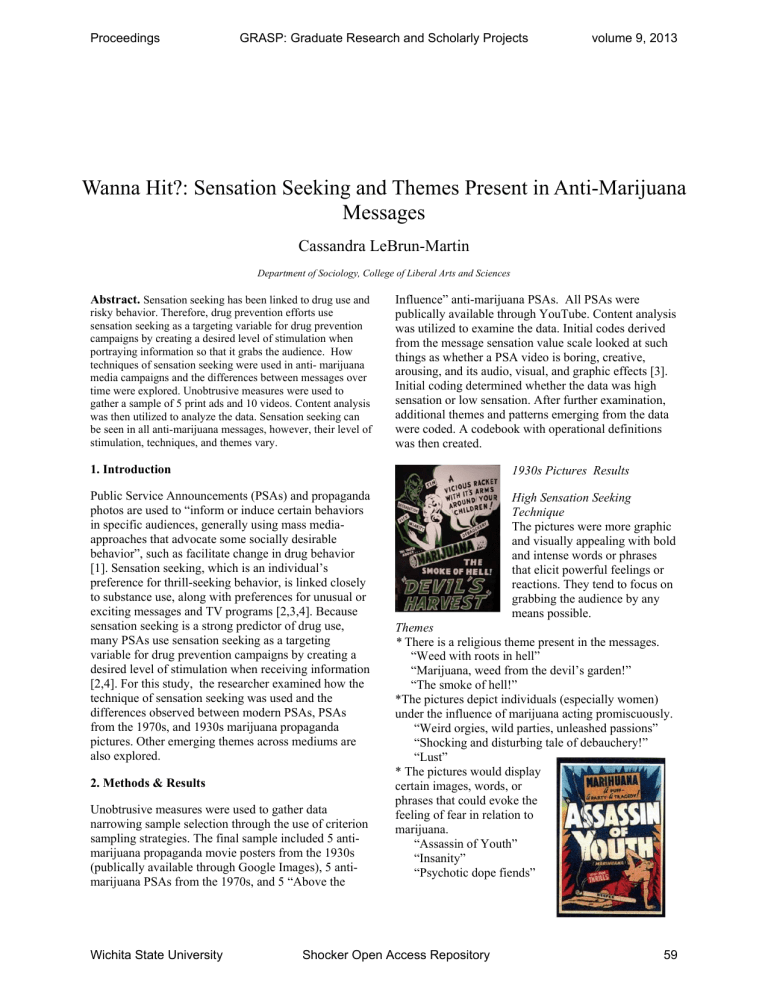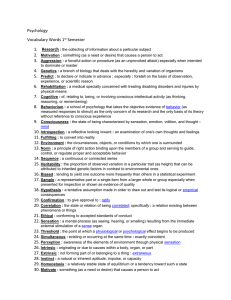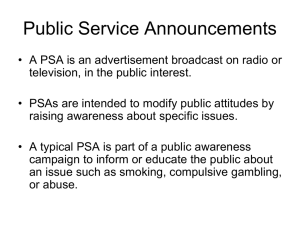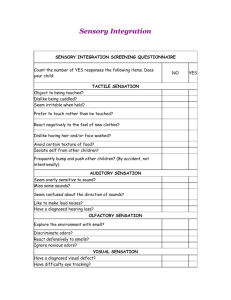Wanna Hit?: Sensation Seeking and Themes Present in Anti-Marijuana Messages Cassandra LeBrun-Martin Abstract.

Proceedings GRASP: Graduate Research and Scholarly Projects volume 9, 2013
Wanna Hit?: Sensation Seeking and Themes Present in Anti-Marijuana
Messages
Cassandra LeBrun-Martin
Department of Sociology, College of Liberal Arts and Sciences
Abstract. Sensation seeking has been linked to drug use and risky behavior. Therefore, drug prevention efforts use sensation seeking as a targeting variable for drug prevention campaigns by creating a desired level of stimulation when portraying information so that it grabs the audience. How techniques of sensation seeking were used in anti- marijuana media campaigns and the differences between messages over time were explored. Unobtrusive measures were used to gather a sample of 5 print ads and 10 videos. Content analysis was then utilized to analyze the data. Sensation seeking can be seen in all anti-marijuana messages, however, their level of stimulation, techniques, and themes vary.
1. Introduction
Public Service Announcements (PSAs) and propaganda photos are used to “inform or induce certain behaviors in specific audiences, generally using mass mediaapproaches that advocate some socially desirable behavior”, such as facilitate change in drug behavior
[1]. Sensation seeking, which is an individual’s preference for thrill-seeking behavior, is linked closely to substance use, along with preferences for unusual or exciting messages and TV programs [2,3,4]. Because sensation seeking is a strong predictor of drug use, many PSAs use sensation seeking as a targeting variable for drug prevention campaigns by creating a desired level of stimulation when receiving information
[2,4]. For this study, the researcher examined how the technique of sensation seeking was used and the differences observed between modern PSAs, PSAs from the 1970s, and 1930s marijuana propaganda pictures. Other emerging themes across mediums are also explored.
2. Methods & Results
Unobtrusive measures were used to gather data narrowing sample selection through the use of criterion sampling strategies. The final sample included 5 antimarijuana propaganda movie posters from the 1930s
(publically available through Google Images), 5 antimarijuana PSAs from the 1970s, and 5 “Above the
Influence” anti-marijuana PSAs. All PSAs were publically available through YouTube. Content analysis was utilized to examine the data. Initial codes derived from the message sensation value scale looked at such things as whether a PSA video is boring, creative, arousing, and its audio, visual, and graphic effects [3].
Initial coding determined whether the data was high sensation or low sensation. After further examination, additional themes and patterns emerging from the data were coded. A codebook with operational definitions was then created.
1930s Pictures Results
High Sensation Seeking
Technique
The pictures were more graphic and visually appealing with bold and intense words or phrases that elicit powerful feelings or reactions. They tend to focus on grabbing the audience by any means possible.
Themes
* There is a religious theme present in the messages.
“Weed with roots in hell”
“Marijuana, weed from the devil’s garden!”
“The smoke of hell!”
*The pictures depict individuals (especially women) under the influence of marijuana acting promiscuously.
“Weird orgies, wild parties, unleashed passions”
“Shocking and disturbing tale of debauchery!”
“Lust”
* The pictures would display certain images, words, or phrases that could evoke the feeling of fear in relation to marijuana.
“Assassin of Youth”
“Insanity”
“Psychotic dope fiends”
Wichita State University Shocker Open Access Repository 59
Proceedings GRASP: Graduate Research and Scholarly Projects volume 9, 2013
1970s PSAs Results
High Sensation
Seeking Techniques
The PSAs were visually appealing by utilizing bright colors and effects.
They contained many sound effects and music. The PSAs used various techniques, such as “funky” music, extreme stories, metaphors, and 70s slang, to grab the audience and appear relatable.
Themes
* Individuals under the influence of marijuana behave unwisely or do not think clearly.
“Users are prone to unpredictable behavior including junk food binges, joy riding, and a sudden urge to wear sunglasses at night.”
“Drugs make you act funny…and look silly.”
“Taking drugs is really dumb.”
* Marijuana is addictive and can lead to other drugs.
“If you use marijuana, before long you’ll have the habit, about the hardest in the world to
break.”
“I needed a fix bad. So bad I didn’t care if I
“Most teenagers start out with marijuana, then turn to heroin.”
* The pictures would display certain images, words, or phrases that could evoke the feeling of fear in relation to marijuana.
“Reaching out to claim its next victim.”
“Causes permanent insanity.”
“A nightmare that even Edgar Allen Poe couldn’t have improved on.”
2000s “Above the
Influence” PSAs Results
Low Sensation Seeking
Techniques
The PSAs may have used odd or unique approaches to gain interest, but overall many were not visually appealing or contain many effects. They tend to focus more on the message of the PSA, rather than trying to grab the audience with effects.
Themes
*Individuals under the influence of marijuana behave unwisely or do not think clearly.
“I got straight D’s!”
“Yo! You left this at the party last night!” (Holds out the kids brain)
“Marijuana can slow your reaction time.
Harmless?”
* Individuals under the influence are not engaging in or involving themselves in any physical activity.
“This is the way it’s been since she started smoking pot. She’s all lazy…and boring…and…you know we used to have so much fun together.”
“We sat on Pete’s couch for 11 hours. Now what’s going to happen on
Pete’s couch?
Nothing.… No, you wanna keep yourself alive, you go over to
Pete’s and sit on his couch till you’re 86.
Safest thing in the world.”
3. Conclusion
As discussed in previous literature, sensation seeking techniques are used to target individuals by grabbing their attention when receiving information [2,4].
Sensation seeking can be seen in all of the antimarijuana messages, however, their level of stimulation, techniques, and themes varied across time.
PSAs appear to have become less driven by shock value over time. Also, the themes present in the data can be explained by the influence and opinions of their own time.
Further Research
Future research interviewing potential targets of media campaigns would provide valuable insights.
Individuals could be asked to observe the pictures and
PSAs in order to gauge their perceptions, reactions, and opinions about the potential effectiveness and appeal of different anti-marijuana message techniques.
4. Acknowledgements: Dr. Jodie Hertzog served as faculty advisor for this project.
[1] Walther, J. B., DeAndrea, D., Kim, J., & Anthony, J. C. (2010).
The influence of online comments on perceptions of antimarijuana public service announcements on youtube. Human Communication
Research, 36, p. 470. Retrieved from 10.1111
[2] Stephenson, M. T., & Palmgreen, P. (2001). Sensation seeking, perceived message sensation value, personal involvement, and processing of anti-marijuana psas. Communication
Monographs,68(1), 49-71. Retrieved from http://dx.doi.org/10.1080/03637750128051
[3] Palmgreen, P., Stephenson, M. T., Everett, M. W., Baseheart, J.
R., & Francies, R. (2002). Perceived message sensation value (pmsv) and the dimensions and validation of a pmsv scale. Health
Communication, 14(4), 403-428.
[4] Stephenson, M. T. (2003). Examining adolescents' responses to anti-marijuana psas. Human Communication Research, 29(3), 343-
369.
Wichita State University Shocker Open Access Repository 60





